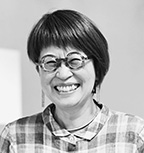Juror
Saito Ayako

[Juror’s Statement]
The Yamagata International Documentary Film Festival has gone online this year. Many people probably hoped that the festival would somehow go forward in person, even in a limited format. But the festival decision was definitely a wise choice in light of the current wave of infection across Japan following the Tokyo Olympics. This new challenge has made a great deal of demand on the festival staff, yet it surely comes as good news for many people who ordinarily were unable to travel to Yamagata.
It has already been a year and a half since the start of the pandemic. COVID-19 has had immeasurable consequences for the film industry. We have heard about the large-scale transitions that have been forced on the modes of film production as such. The number of people streaming films has been overtaking the number of people seeing them in theaters, and it has decidedly become a thing of the past to feel surprised when hearing about students viewing films on smartphones. It even seems that the Japanese verb conventionally used primarily for “watching” television (shicho suru) has been largely accepted as a way to describe “seeing” (miru) films. Of course, if we look back over the history of film viewership and production, we have long been accustomed to watching movies on television, and production equipment has also progressively miniaturized to the extent that it is no longer surprising to hear about films being shot on smartphones. Such choices are often driven by response to state violence, natural disasters, and man-made calamities. Under these circumstances, 35mm and 16mm cameras, video cameras, iPads, and smartphones have all become both weapons and witnesses.
As the pandemic continues to rage around the globe, and in a changing world with changing technology and for the benefit of people whose lives are changing, films themselves must inevitably change as well. The pandemic is not the only challenge. Violent coercion by authoritarian regimes, militaries, and extreme fundamentalist movements has been intensifying, and those demonstrating in protest have been oppressed and disempowered. Things that happened in Algeria, Chile, South Africa, Cambodia, Palestine, Rwanda, Kwangju, Tiananmen, and Syria are currently happening in Hong Kong, Afghanistan, and Myanmar. Oshima Nagisa once said, “the defeated have no images.” But whether as fiction or as nonfiction, films have demonstrated that power cannot completely erase reality or history, however hard it may try to manipulate images. At the same time, moving images have also continued to depict the light and shadows of the world from within microcosms of the personal. This film festival has long brought us a wealth of such images.
It is said that under the pandemic the significance inherent in culture and art has been called into question. But significance is not something in easy grasp, it is something we find for ourselves. People have always needed images, as documents and as stories, and that is not about to change. Documentaries will continue to be made, and we will continue to watch them. How should we look at films in a changing world? As a juror, I will undoubtedly not “judge” as much as I will “be judged” myself.
Professor in the Department of Art Studies at Meiji Gakuin University. She earned her PhD from UCLA School of Theater, Film and Television, and specializes in film theory, particularly feminist and psychoanalytic film theory. She has served on the jury of the Seoul International Women’s Film Festival and as a coordinator of the Aichi International Women’s Film Festival. Her co-authored and co-edited books (in Japanese) include Wakao Ayako, Film Actress (Misuzu Shobo, 2003), Male Bonding: East Asian Cinema and Homosociality (Heibonsha, 2004), Film and Body/Sexuality (Shinwasha, 2006), Transversing Film and Literature (Shinwasha, 2011), and Invisibility: Representation of Invisible Race—Dismantling the Race Myth Vol. 1 (University of Tokyo Press, 2016). Her published articles include “The World Viewed by Wang Bing” (Geijutsugaku kenkyu 23, 2013), “The Politics of Listening and the Narration of Trauma in Sakai Ko and Hamaguchi Ryusuke’s Tohoku Trilogy” (Geijutsugaku kenkyu 26, 2016), and “Kinuyo and Sumie: When Women Write and Direct” in Tanaka Kinuyo: Nation, Stardom and Female Subjectivity, eds., I. González-López/M. Smith (Edinburgh UP, 2019).
